Advances in Chirality Sensing with Macrocyclic Molecules
Abstract
:1. Introduction
2. Achiral Macrocyclic Host
2.1. Chirality Sensing with Cucurbit[n]urils
2.2. Macrocyclic Naphthalene Derivatives
2.3. Pillar[n]arenes
2.4. Cyclic Octapyrroles
2.5. TPE-Based Macrocycle
2.6. Other Macrocycles
3. Chiral Macrocyclic Host
3.1. BINOL-Based Macrocycle
3.2. Triptycene-Based Macrocycle
3.3. Bambusurils
3.4. Other Chiral Macrocyclic Compounds
4. Conclusions
Author Contributions
Funding
Institutional Review Board Statement
Informed Consent Statement
Data Availability Statement
Acknowledgments
Conflicts of Interest
References
- Zhang, X.; Yin, J.; Yoon, J. Recent advances in development of chiral fluorescent and colorimetric sensors. Chem. Rev. 2014, 114, 4918–4959. [Google Scholar] [CrossRef] [PubMed]
- Jo, H.H.; Lin, C.Y.; Anslyn, E.V. Rapid optical methods for enantiomeric excess analysis: From enantioselective indicator displacement assays to exciton-coupled circular dichroism. Acc. Chem. Res. 2014, 47, 2212–2221. [Google Scholar] [CrossRef] [PubMed]
- Wolf, C.; Bentley, K.W. Chirality sensing using stereodynamic probes with distinct electronic circular dichroism output. Chem. Soc. Rev. 2013, 42, 5408–5424. [Google Scholar] [CrossRef] [PubMed]
- Hembury, G.A.; Borovkov, V.V.; Inoue, Y. Chirality-Sensing Supramolecular Systems. Chem. Rev. 2008, 108, 1–73. [Google Scholar] [CrossRef]
- Chen, Z.; Wang, Q.; Wu, X.; Li, Z.; Jiang, Y.-B. Optical chirality sensing using macrocycles, synthetic and supramolecular oligomers/polymers, and nanoparticle based sensors. Chem. Soc. Rev. 2015, 44, 4249–4263. [Google Scholar] [CrossRef]
- Huang, S.; Yu, H.; Li, Q. Supramolecular Chirality Transfer toward Chiral Aggregation: Asymmetric Hierarchical Self-Assembly. Adv. Sci. 2021, 8, 2002132. [Google Scholar] [CrossRef]
- Prabodh, A.; Bauer, D.; Kubik, S.; Rebmann, P.; Klarner, F.G.; Schrader, T.; Delarue Bizzini, L.; Mayor, M.; Biedermann, F. Chirality sensing of terpenes, steroids, amino acids, peptides and drugs with acyclic cucurbit[n]urils and molecular tweezers. Chem. Commun. 2020, 56, 4652–4655. [Google Scholar] [CrossRef] [Green Version]
- Wang, L.L.; Quan, M.; Yang, T.L.; Chen, Z.; Jiang, W. A Green and Wide-Scope Approach for Chiroptical Sensing of Organic Molecules through Biomimetic Recognition in Water. Angew. Chem. Int. Ed. Engl. 2020, 59, 23817–23824. [Google Scholar] [CrossRef]
- Ada, N.-H.; Nakanishi, K. Circular Dichroic Spectroscopy: Exciton Coupling in Organic Stereochemistry; University Science Books: Mill Valley, CA, USA, 1983. [Google Scholar]
- Rekharsky, M.V.; Yamamura, H.; Inoue, C.; Kawai, M.; Osaka, I.; Arakawa, R.; Shiba, K.; Sato, A.; Ko, Y.H.; Selvapalam, N.; et al. Chiral Recognition in Cucurbituril Cavities. J. Am. Chem. Soc. 2006, 128, 14871–14880. [Google Scholar] [CrossRef]
- Bailey, D.M.; Hennig, A.; Uzunova, V.D.; Nau, W.M. Supramolecular tandem enzyme assays for multiparameter sensor arrays and enantiomeric excess determination of amino acids. Chem. Eur. J. 2008, 14, 6069–6077. [Google Scholar] [CrossRef]
- Biedermann, F.; Nau, W.M. Noncovalent chirality sensing ensembles for the detection and reaction monitoring of amino acids, peptides, proteins, and aromatic drugs. Angew. Chem. Int. Ed. Engl. 2014, 53, 5694–5699. [Google Scholar] [CrossRef]
- Hassan, D.S.; De Los Santos, Z.A.; Brady, K.G.; Murkli, S.; Isaacs, L.; Wolf, C. Chiroptical sensing of amino acids, amines, amino alcohols, alcohols and terpenes with pi-extended acyclic cucurbiturils. Org. Biomol. Chem. 2021, 19, 4248–4253. [Google Scholar] [CrossRef]
- Wang, L.L.; Chen, Z.; Liu, W.E.; Ke, H.; Wang, S.H.; Jiang, W. Molecular Recognition and Chirality Sensing of Epoxides in Water Using Endo-Functionalized Molecular Tubes. J. Am. Chem. Soc. 2017, 139, 8436–8439. [Google Scholar] [CrossRef]
- Chai, H.; Chen, Z.; Wang, S.-H.; Quan, M.; Yang, L.-P.; Ke, H.; Jiang, W. Enantioselective Recognition of Neutral Molecules in Water by a Pair of Chiral Biomimetic Macrocyclic Receptors. CCS Chem. 2020, 2, 440–452. [Google Scholar] [CrossRef]
- Huang, X.; Wang, X.; Quan, M.; Yao, H.; Ke, H.; Jiang, W. Biomimetic Recognition and Optical Sensing of Carboxylic Acids in Water by Using a Buried Salt Bridge and the Hydrophobic Effect. Angew. Chem. Int. Ed. Engl. 2021, 60, 1929–1935. [Google Scholar] [CrossRef]
- Osawa, K.; Tagaya, H.; Kondo, S.I. Induced Circular Dichroism of Achiral Cyclic Bisurea via Hydrogen Bonds with Chiral Carboxylates. J. Org. Chem. 2019, 84, 6623–6630. [Google Scholar] [CrossRef]
- Ogoshi, T.; Kanai, S.; Fujinami, S.; Yamagishi, T.-A.; Nakamoto, Y. para-Bridged Symmetrical Pillar[5]arenes: Their Lewis Acid Catalyzed Synthesis and Host–Guest Property. J. Am. Chem. Soc. 2008, 130, 5022–5023. [Google Scholar] [CrossRef]
- Yao, J.; Wu, W.; Liang, W.; Feng, Y.; Zhou, D.; Chruma, J.J.; Fukuhara, G.; Mori, T.; Inoue, Y.; Yang, C. Temperature-Driven Planar Chirality Switching of a Pillar[5]arene-Based Molecular Universal Joint. Angew. Chem. Int. Ed. 2017, 56, 6869–6873. [Google Scholar] [CrossRef]
- Xiao, C.; Wu, W.; Liang, W.; Zhou, D.; Kanagaraj, K.; Cheng, G.; Su, D.; Zhong, Z.; Chruma, J.J.; Yang, C. Redox-Triggered Chirality Switching and Guest-Capture/Release with a Pillar[6]arene-Based Molecular Universal Joint. Angew. Chem. Int. Ed. 2020, 59, 8094–8098. [Google Scholar] [CrossRef]
- Yao, J.; Wu, W.; Xiao, C.; Su, D.; Zhong, Z.; Mori, T.; Yang, C. Overtemperature-protection intelligent molecular chiroptical photoswitches. Nat. Commun. 2021, 12, 2600. [Google Scholar] [CrossRef]
- Fan, C.; Yao, J.; Li, G.; Guo, C.; Wu, W.; Su, D.; Zhong, Z.; Zhou, D.; Wang, Y.; Chruma, J.J.; et al. Precise Manipulation of Temperature-Driven Chirality Switching of Molecular Universal Joints through Solvent Mixing. Chem. Eur. J. 2019, 25, 12526–12537. [Google Scholar] [CrossRef]
- Liu, C.; Yao, J.; Xiao, C.; Zhao, T.; Selvapalam, N.; Zhou, C.; Wu, W.; Yang, C. Electrochemiluminescent Chiral Discrimination with a Pillar[5]arene Molecular Universal Joint-Coordinated Ruthenium Complex. Org. Lett. 2021, 23, 3885–3890. [Google Scholar] [CrossRef]
- Xiao, C.; Liang, W.; Wu, W.; Kanagaraj, K.; Yang, Y.; Wen, K.; Yang, C. Resolution and Racemization of a Planar-Chiral A1/A2-Disubstituted Pillar[5]arene. Symmetry 2019, 11, 773. [Google Scholar] [CrossRef] [Green Version]
- Li, G.; Fan, C.; Cheng, G.; Wu, W.; Yang, C. Synthesis, enantioseparation and photophysical properties of planar-chiral pillar[5]arene derivatives bearing fluorophore fragments. Beilstein J. Org. Chem. 2019, 15, 1601–1611. [Google Scholar] [CrossRef] [Green Version]
- Yao, J.; Mizuno, H.; Xiao, C.; Wu, W.; Inoue, Y.; Yang, C.; Fukuhara, G. Pressure-driven, solvation-directed planar chirality switching of cyclophano-pillar[5]arenes (molecular universal joints). Chem. Sci. 2021, 12, 4361–4366. [Google Scholar] [CrossRef]
- Ji, J.; Li, Y.; Xiao, C.; Cheng, G.; Luo, K.; Gong, Q.; Zhou, D.; Chruma, J.J.; Wu, W.; Yang, C. Supramolecular enantiomeric and structural differentiation of amino acid derivatives with achiral pillar[5]arene homologs. Chem. Commun. 2020, 56, 161–164. [Google Scholar] [CrossRef]
- Zhu, H.; Li, Q.; Gao, Z.; Wang, H.; Shi, B.; Wu, Y.; Shangguan, L.; Hong, X.; Wang, F.; Huang, F. Pillararene Host-Guest Complexation Induced Chirality Amplification: A New Way to Detect Cryptochiral Compounds. Angew. Chem. Int. Ed. Engl. 2020, 59, 10868–10872. [Google Scholar] [CrossRef]
- Chen, Y.; Fu, L.; Sun, B.; Qian, C.; Wang, R.; Jiang, J.; Lin, C.; Ma, J.; Wang, L. Competitive Selection of Conformation Chirality of Water-Soluble Pillar[5]arene Induced by Amino Acid Derivatives. Org. Lett. 2020, 22, 2266–2270. [Google Scholar] [CrossRef]
- Chen, Y.; Fu, L.; Sun, B.; Qian, C.; Pangannaya, S.; Zhu, H.; Ma, J.; Jiang, J.; Ni, Z.; Wang, R.; et al. Selection of Planar Chiral Conformations between Pillar[5,6]arenes Induced by Amino Acid Derivatives in Aqueous Media. Chem. Eur. J. 2021, 27, 5890–5896. [Google Scholar] [CrossRef]
- Fa, S.; Egami, K.; Adachi, K.; Kato, K.; Ogoshi, T. Sequential Chiral Induction and Regulator-Assisted Chiral Memory of Pillar[5]arenes. Angew. Chem. Int. Ed. Engl. 2020, 59, 20353–20356. [Google Scholar] [CrossRef]
- Setsune, J.; Tsukajima, A.; Okazaki, N.; Lintuluoto, J.M.; Lintuluoto, M. Enantioselective induction of helical chirality in cyclooctapyrroles by metal-complex formation. Angew. Chem. Int. Ed. Engl. 2009, 48, 771–775. [Google Scholar] [CrossRef] [PubMed]
- Ie, M.; Setsune, J.-I.; Eda, K.; Tsuda, A. Chiroptical sensing of oligonucleotides with a cyclic octapyrrole. Org. Chem. Front. 2015, 2, 29–33. [Google Scholar] [CrossRef]
- Xiong, J.B.; Feng, H.T.; Sun, J.P.; Xie, W.Z.; Yang, D.; Liu, M.; Zheng, Y.S. The Fixed Propeller-Like Conformation of Tetraphenylethylene that Reveals Aggregation-Induced Emission Effect, Chiral Recognition, and Enhanced Chiroptical Property. J. Am. Chem. Soc. 2016, 138, 11469–11472. [Google Scholar] [CrossRef] [PubMed]
- Zhang, H.; Cheng, L.; Nian, H.; Du, J.; Chen, T.; Cao, L. Adaptive chirality of achiral tetraphenylethene-based tetracationic cyclophanes with dual responses of fluorescence and circular dichroism in water. Chem. Commun. 2021, 57, 3135–3138. [Google Scholar] [CrossRef]
- Cheng, L.; Liu, K.; Duan, Y.; Duan, H.; Li, Y.; Gao, M.; Cao, L. Adaptive Chirality of an Achiral Cage: Chirality Transfer, Induction, and Circularly Polarized Luminescence through Aqueous Host–Guest Complexation. CCS Chem. 2020, 2749–2751. [Google Scholar] [CrossRef]
- Sapotta, M.; Spenst, P.; Saha-Möller, C.R.; Würthner, F. Guest-mediated chirality transfer in the host–guest complexes of an atropisomeric perylene bisimide cyclophane host. Org. Chem. Front. 2019, 6, 892–899. [Google Scholar] [CrossRef]
- Nian, H.; Cheng, L.; Wang, L.; Zhang, H.; Wang, P.; Li, Y.; Cao, L. Hierarchical Two-Level Supramolecular Chirality of an Achiral Anthracene-Based Tetracationic Nanotube in Water. Angew. Chem. Int. Ed. Engl. 2021, 133, 15482–15486. [Google Scholar] [CrossRef]
- Weirich, L.; Merten, C. Induced VCD and conformational chirality in host-guest complexes of a chiral ammonium salt with crown ethers. Phys. Chem. Chem. Phys. 2021, 23, 18300–18307. [Google Scholar] [CrossRef]
- Liu, H.L.; Hou, X.L.; Pu, L. Enantioselective precipitation and solid-state fluorescence enhancement in the recognition of alpha-hydroxycarboxylic acids. Angew. Chem. Int. Ed. Engl. 2009, 48, 382–385. [Google Scholar] [CrossRef]
- Yu, S.; Pu, L. Pseudoenantiomeric Fluorescent Sensors in a Chiral Assay. J. Am. Chem. Soc. 2010, 132, 17698–17700. [Google Scholar] [CrossRef]
- Akdeniz, A.; Minami, T.; Watanabe, S.; Yokoyama, M.; Ema, T.; Anzenbacher, P., Jr. Determination of enantiomeric excess of carboxylates by fluorescent macrocyclic sensors. Chem. Sci. 2016, 7, 2016–2022. [Google Scholar] [CrossRef] [Green Version]
- Tyszka-Gumkowska, A.; Pikus, G.; Jurczak, J. Chiral Recognition of Carboxylate Anions by (R)-BINOL-Based Macrocyclic Receptors. Molecules 2019, 24, 2635. [Google Scholar] [CrossRef] [Green Version]
- Abe, H.; Yoneda, T.; Ohishi, Y.; Inouye, M. D3h-Symmetrical Shape-Persistent Macrocycles Consisting of Pyridine-Acetylene-Phenol Conjugates as an Efficient Host Architecture for Saccharide Recognition. Chem. Eur. J. 2016, 22, 18944–18952. [Google Scholar] [CrossRef]
- Lim, J.Y.C.; Marques, I.; Felix, V.; Beer, P.D. Enantioselective Anion Recognition by Chiral Halogen-Bonding [2]Rotaxanes. J. Am. Chem. Soc. 2017, 139, 12228–12239. [Google Scholar] [CrossRef]
- Ohishi, Y.; Murase, M.; Abe, H.; Inouye, M. Enantioselective Solid-Liquid Extraction of Native Saccharides with Chiral BINOL-Based Pyridine-Phenol Type Macrocycles. Org. Lett. 2019, 21, 6202–6207. [Google Scholar] [CrossRef]
- Zhang, G.W.; Li, P.F.; Meng, Z.; Wang, H.X.; Han, Y.; Chen, C.F. Triptycene-Based Chiral Macrocyclic Hosts for Highly Enantioselective Recognition of Chiral Guests Containing a Trimethylamino Group. Angew. Chem. Int. Ed. Engl. 2016, 55, 5304–5308. [Google Scholar] [CrossRef]
- Guo, Y.; Han, Y.; Chen, C.F. Construction of Chiral Nanoassemblies Based on Host-Guest Complexes and Their Responsive CD and CPL Properties: Chirality Transfer From 2,6-helic[6]arenes to a Stilbazolium Derivative. Front. Chem. 2019, 7, 543. [Google Scholar] [CrossRef] [Green Version]
- Li, J.; Han, Y.; Chen, C.F. Synthesis of Chiral Helic[1]triptycene[3]arenes and Their Enantioselective Recognition Towards Chiral Guests Containing Aminoindan Groups. Molecules 2021, 26, 536. [Google Scholar] [CrossRef]
- Lisbjerg, M.; Jessen, B.M.; Rasmussen, B.; Nielsen, B.E.; Madsen, A.Ø.; Pittelkow, M. Discovery of a cyclic 6 + 6 hexamer of d-biotin and formaldehyde. Chem. Sci. 2014, 5, 2647–2650. [Google Scholar] [CrossRef] [Green Version]
- Aav, R.; Shmatova, E.; Reile, I.; Borissova, M.; Topić, F.; Rissanen, K. New Chiral Cyclohexylhemicucurbit[6]uril. Org. Lett. 2013, 15, 3786–3789. [Google Scholar] [CrossRef]
- Sokolov, J.; Sindelar, V. Chiral Bambusurils for Enantioselective Recognition of Carboxylate Anion Guests. Chem. Eur. J. 2018, 24, 15482–15485. [Google Scholar] [CrossRef]
- Sokolov, J.; Stefek, A.; Sindelar, V. Functionalized Chiral Bambusurils: Synthesis and Host-Guest Interactions with Chiral Carboxylates. Chempluschem 2020, 85, 1307–1314. [Google Scholar] [CrossRef]
- Nemat, S.J.; Jedrzejewska, H.; Prescimone, A.; Szumna, A.; Tiefenbacher, K. Catechol[4]arene: The Missing Chiral Member of the Calix[4]arene Family. Org. Lett. 2020, 22, 5506–5510. [Google Scholar] [CrossRef]
- Quan, J.; Nie, G.; Xue, H.; Luo, L.; Zhang, R.; Li, H. Macroscopic Chiral Recognition by Calix[4]arene-Based Host-Guest Interactions. Chem. Eur. J. 2018, 24, 15502–15506. [Google Scholar] [CrossRef]
- Zhang, W.-Z.; Ma, H.; Xiang, G.-Y.; Luo, J.; Chung, W.-S. Calix[4]arenes with Combined Axial Chirality and Inherent Chirality: Synthesis, Absolute Configuration and Chiral Recognition. ChemistrySelect 2016, 1, 2486–2491. [Google Scholar] [CrossRef]
- Sun, Y.; Mei, Y.; Quan, J.; Xiao, X.; Zhang, L.; Tian, D.; Li, H. The macroscopic wettable surface: Fabricated by calix[4]arene-based host-guest interaction and chiral discrimination of glucose. Chem. Commun. 2016, 52, 14416–14418. [Google Scholar] [CrossRef]
- Yang, C. Recent progress in supramolecular chiral photochemistry. Chin. Chem. Lett. 2013, 24, 437–441. [Google Scholar] [CrossRef]
- Yang, C.; Inoue, Y. Supramolecular photochirogenesis. Chem. Soc. Rev. 2014, 43, 4123–4143. [Google Scholar] [CrossRef] [PubMed]
- Ji, J.; Wu, W.; Liang, W.; Cheng, G.; Matsushita, R.; Yan, Z.; Wei, X.; Rao, M.; Yuan, D.-Q.; Fukuhara, G.; et al. An Ultimate Stereocontrol in Supramolecular Photochirogenesis: Photocyclodimerization of 2-Anthracenecarboxylate Mediated by Sulfur-Linked β-Cyclodextrin Dimers. J. Am. Chem. Soc. 2019, 141, 9225–9238. [Google Scholar] [CrossRef] [PubMed]
- Ji, J.; Wu, W.; Wei, X.; Rao, M.; Zhou, D.; Cheng, G.; Gong, Q.; Luo, K.; Yang, C. Synergetic effects in the enantiodifferentiating photocyclodimerization of 2-anthracenecarboxylic acid mediated by β-cyclodextrin–pillar[5]arene-hybridized hosts. Chem. Commun. 2020, 56, 6197–6200. [Google Scholar] [CrossRef] [PubMed]
- Yan, Z.; Huang, Q.; Liang, W.; Yu, X.; Zhou, D.; Wu, W.; Chruma, J.J.; Yang, C. Enantiodifferentiation in the Photoisomerization of (Z,Z)-1,3-Cyclooctadiene in the Cavity of γ-Cyclodextrin–Curcubit[6]uril-Wheeled [4]Rotaxanes with an Encapsulated Photosensitizer. Org. Lett. 2017, 19, 898–901. [Google Scholar] [CrossRef]
- Dai, L.; Wu, W.; Liang, W.; Chen, W.; Yu, X.; Ji, J.; Xiao, C.; Yang, C. Enhanced chiral recognition by γ-cyclodextrin–cucurbit[6]uril-cowheeled [4]pseudorotaxanes. Chem. Comm. 2018, 54, 2643–2646. [Google Scholar] [CrossRef]
- Yu, X.; Liang, W.; Huang, Q.; Wu, W.; Chruma, J.J.; Yang, C. Room-temperature phosphorescent γ-cyclodextrin-cucurbit[6]uril-cowheeled [4]rotaxanes for specific sensing of tryptophan. Chem. Commun. 2019, 55, 3156–3159. [Google Scholar] [CrossRef]
- Liu, R.; Zhang, Y.; Wu, W.; Liang, W.; Huang, Q.; Yu, X.; Xu, W.; Zhou, D.; Selvapalam, N.; Yang, C. Temperature-driven braking of γ-cyclodextrin-curcubit[6]uril-cowheeled [4]rotaxanes. Chin. Chem. Lett. 2019, 30, 577–581. [Google Scholar] [CrossRef]
- Feng, H.T.; Zhang, X.; Zheng, Y.S. Fluorescence Turn-on Enantioselective Recognition of both Chiral Acidic Compounds and alpha-Amino Acids by a Chiral Tetraphenylethylene Macrocycle Amine. J. Org. Chem. 2015, 80, 8096–8101. [Google Scholar] [CrossRef]
- Della Sala, P.; Del Regno, R.; Talotta, C.; Capobianco, A.; Hickey, N.; Geremia, S.; De Rosa, M.; Spinella, A.; Soriente, A.; Neri, P.; et al. Prismarenes: A New Class of Macrocyclic Hosts Obtained by Templation in a Thermodynamically Controlled Synthesis. J. Am. Chem. Soc. 2020, 142, 1752–1756. [Google Scholar] [CrossRef]
- Han, X.N.; Han, Y.; Chen, C.F. Pagoda[4]arene and i-Pagoda[4]arene. J. Am. Chem. Soc. 2020, 142, 8262–8269. [Google Scholar] [CrossRef]
- Wang, J.; Ju, Y.Y.; Low, K.H.; Tan, Y.Z.; Liu, J. A Molecular Transformer: A pi-Conjugated Macrocycle as an Adaptable Host. Angew. Chem. Int. Ed. Engl. 2021, 60, 11814–11818. [Google Scholar] [CrossRef]
- Liu, Y.; Wang, H.; Shangguan, L.; Liu, P.; Shi, B.; Hong, X.; Huang, F. Selective Separation of Phenanthrene from Aromatic Isomer Mixtures by a Water-Soluble Azobenzene-Based Macrocycle. J. Am. Chem. Soc. 2021, 143, 3081–3085. [Google Scholar] [CrossRef]
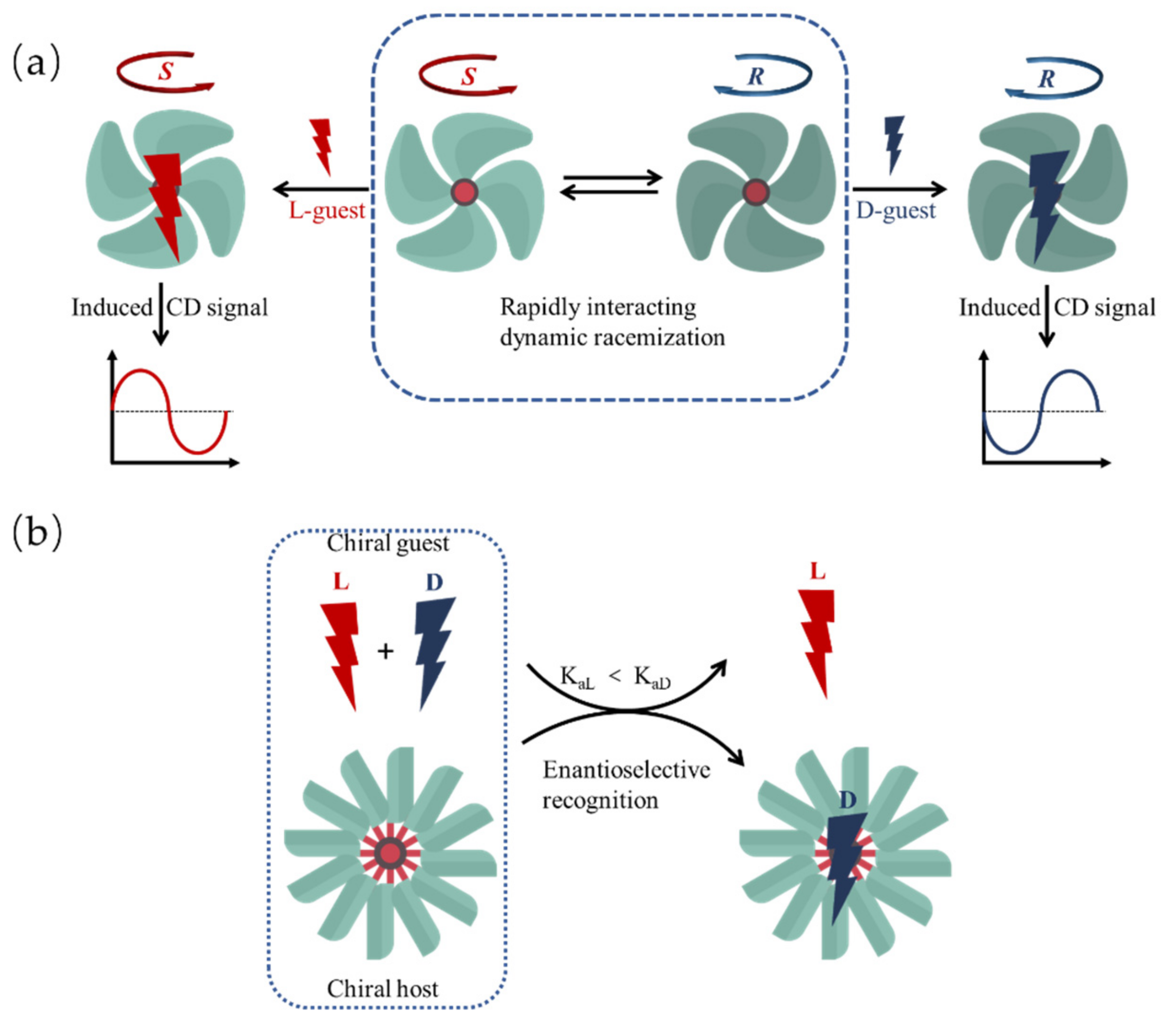
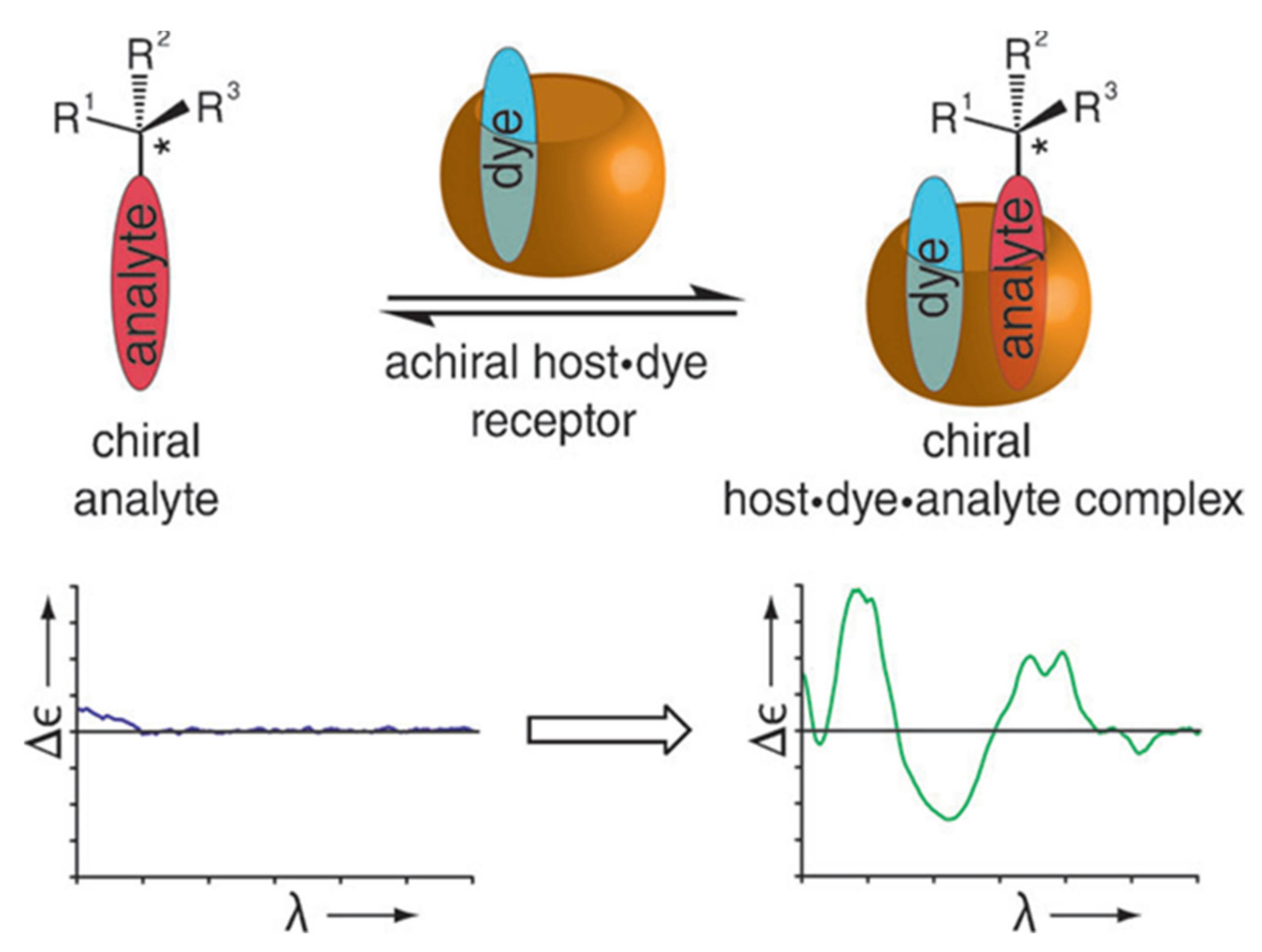

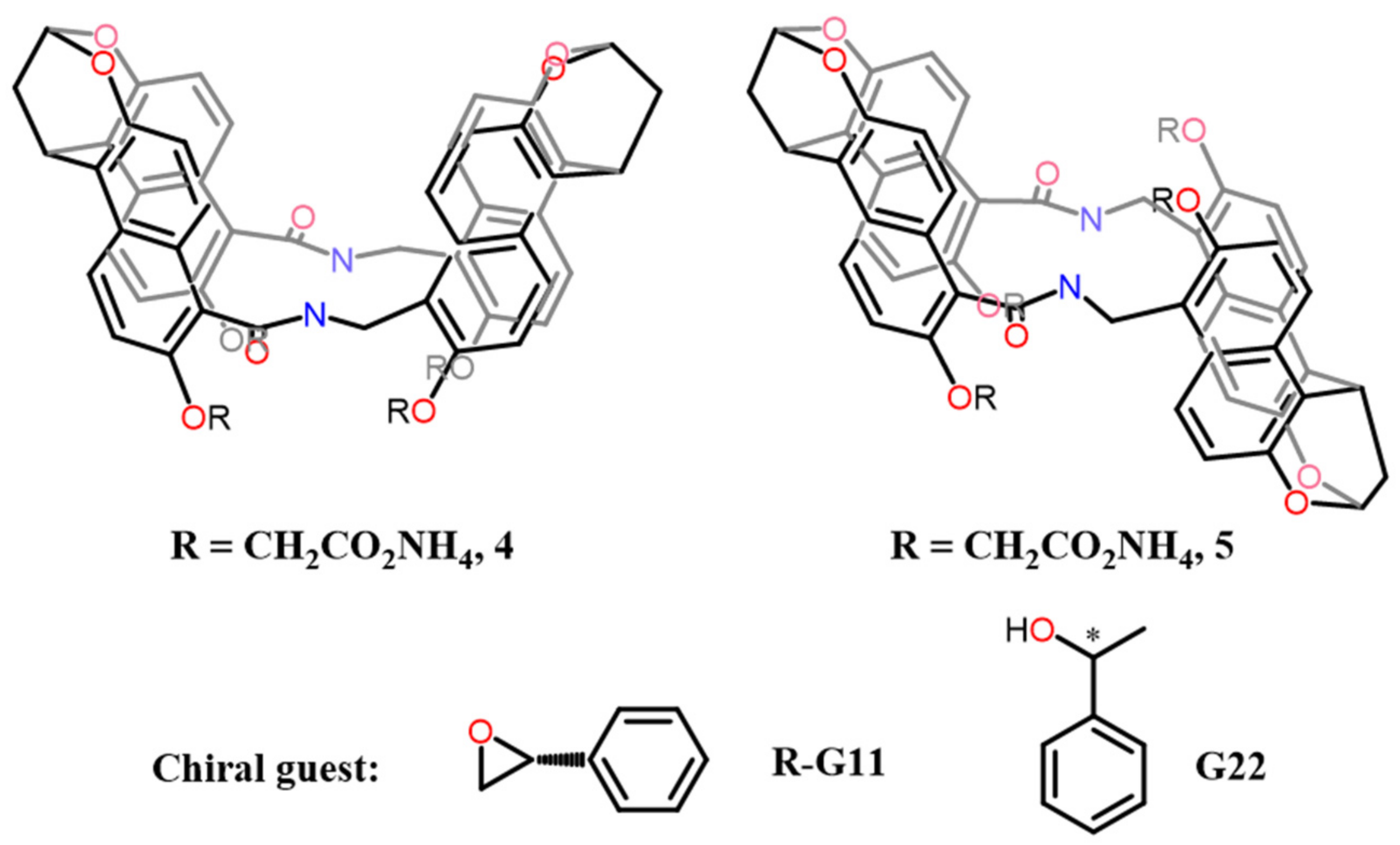
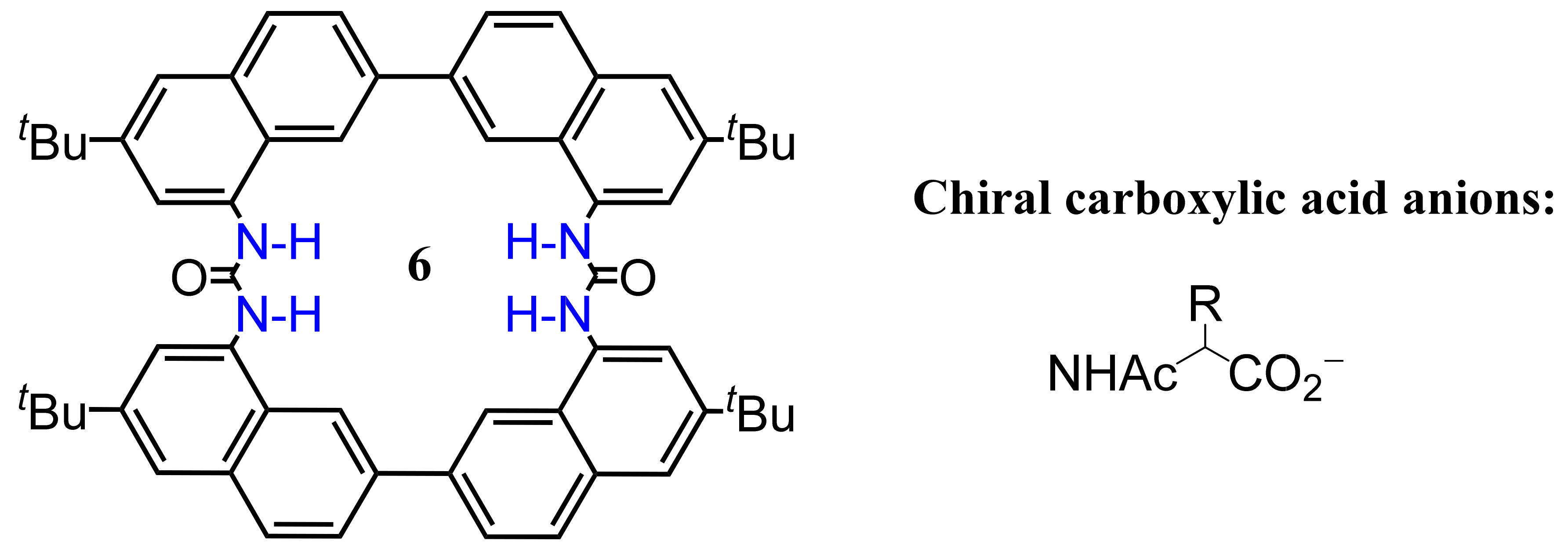


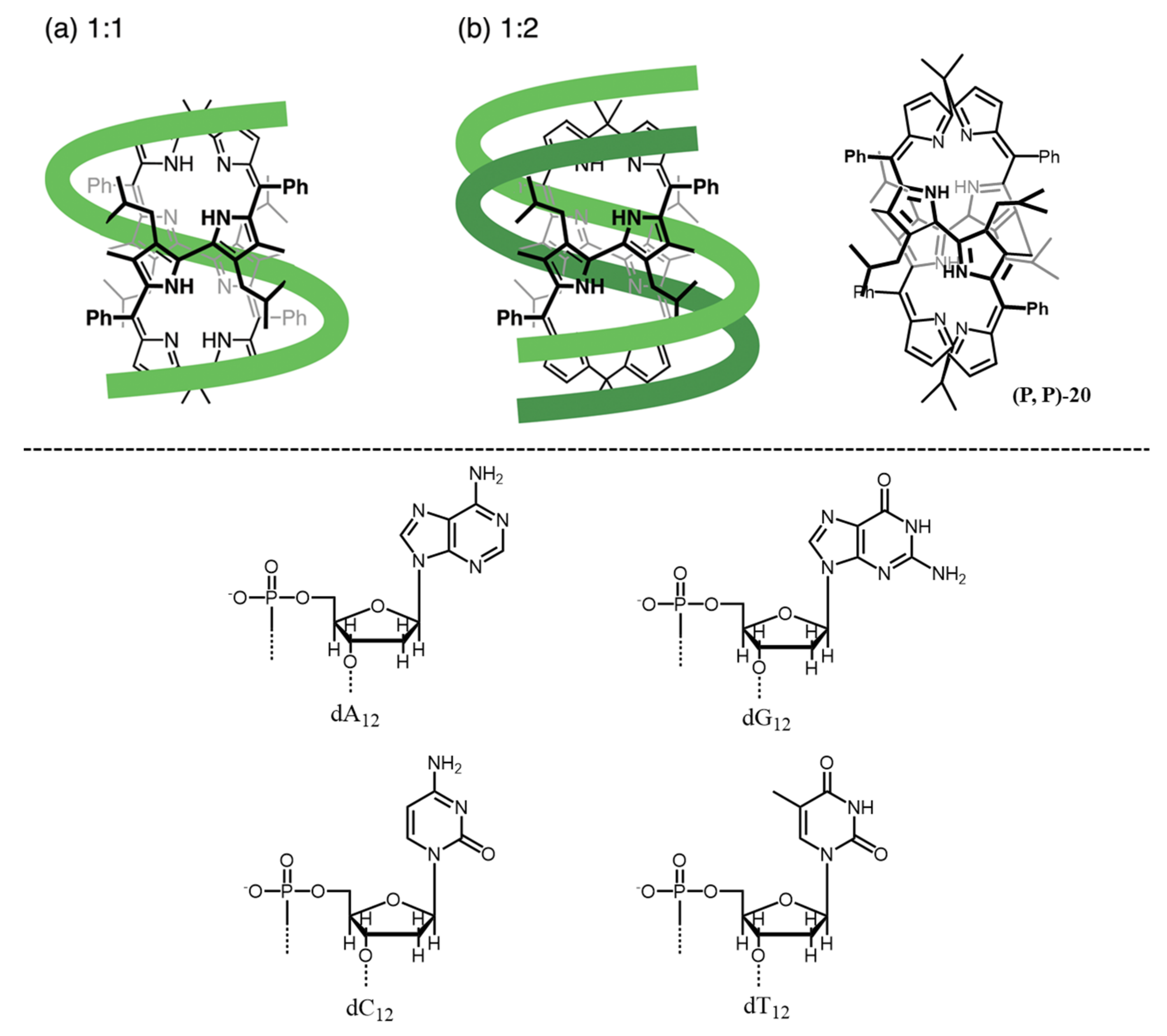

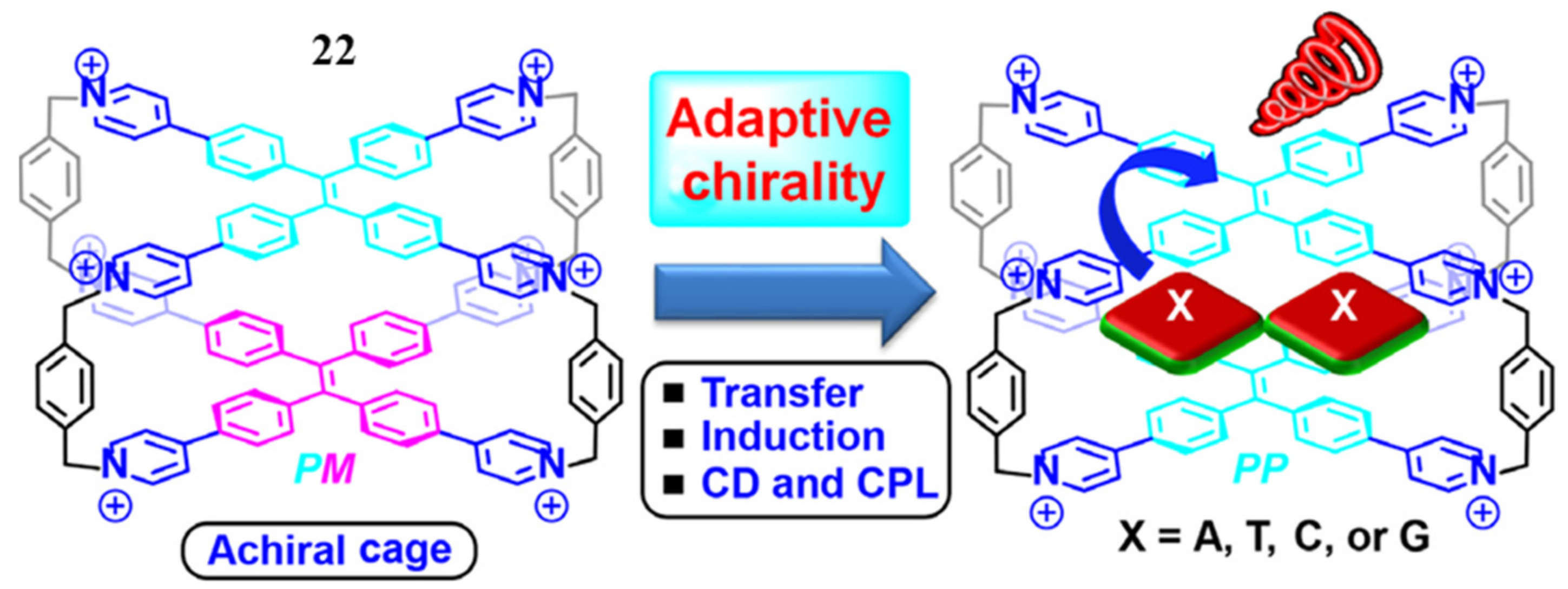
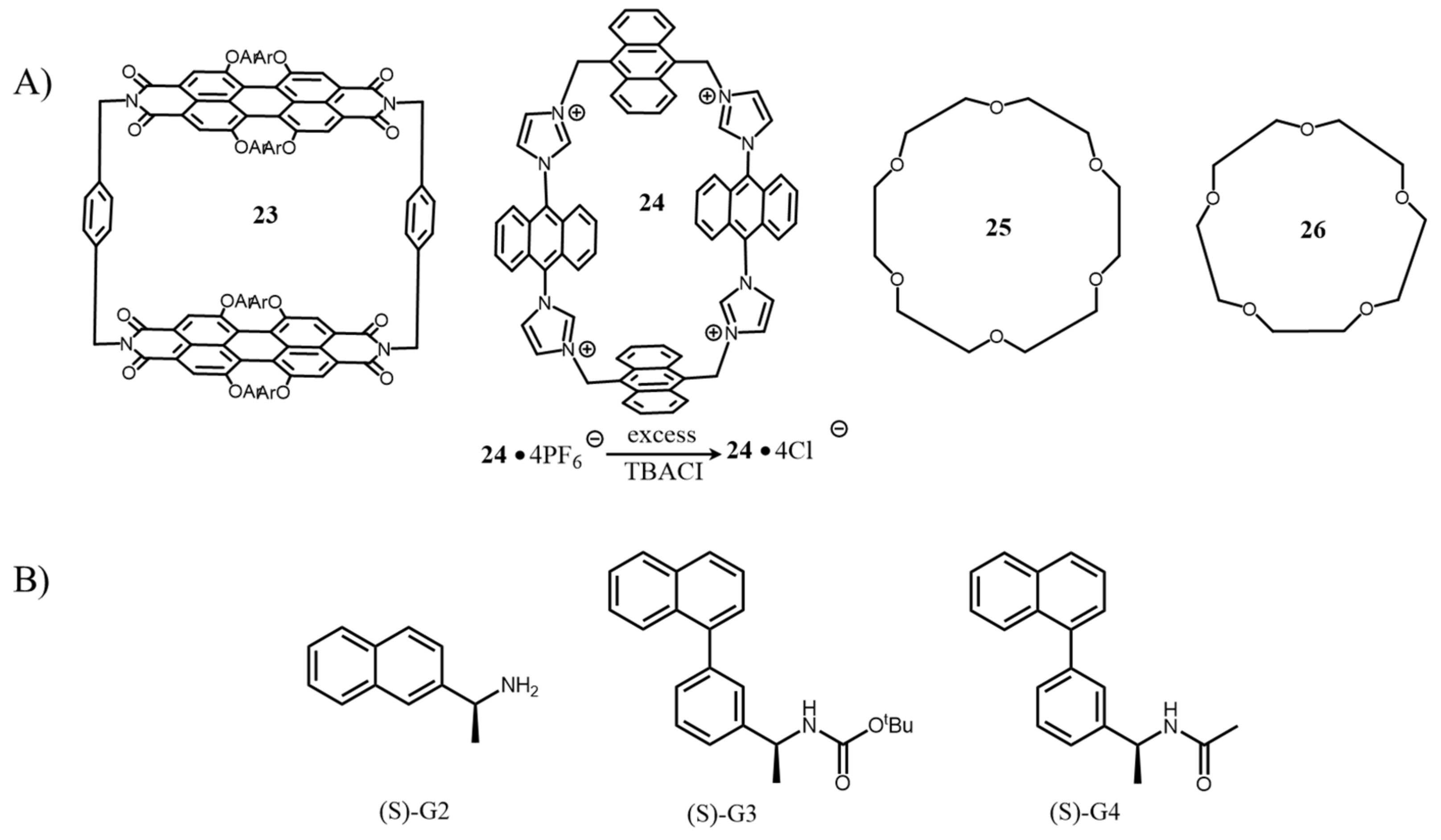
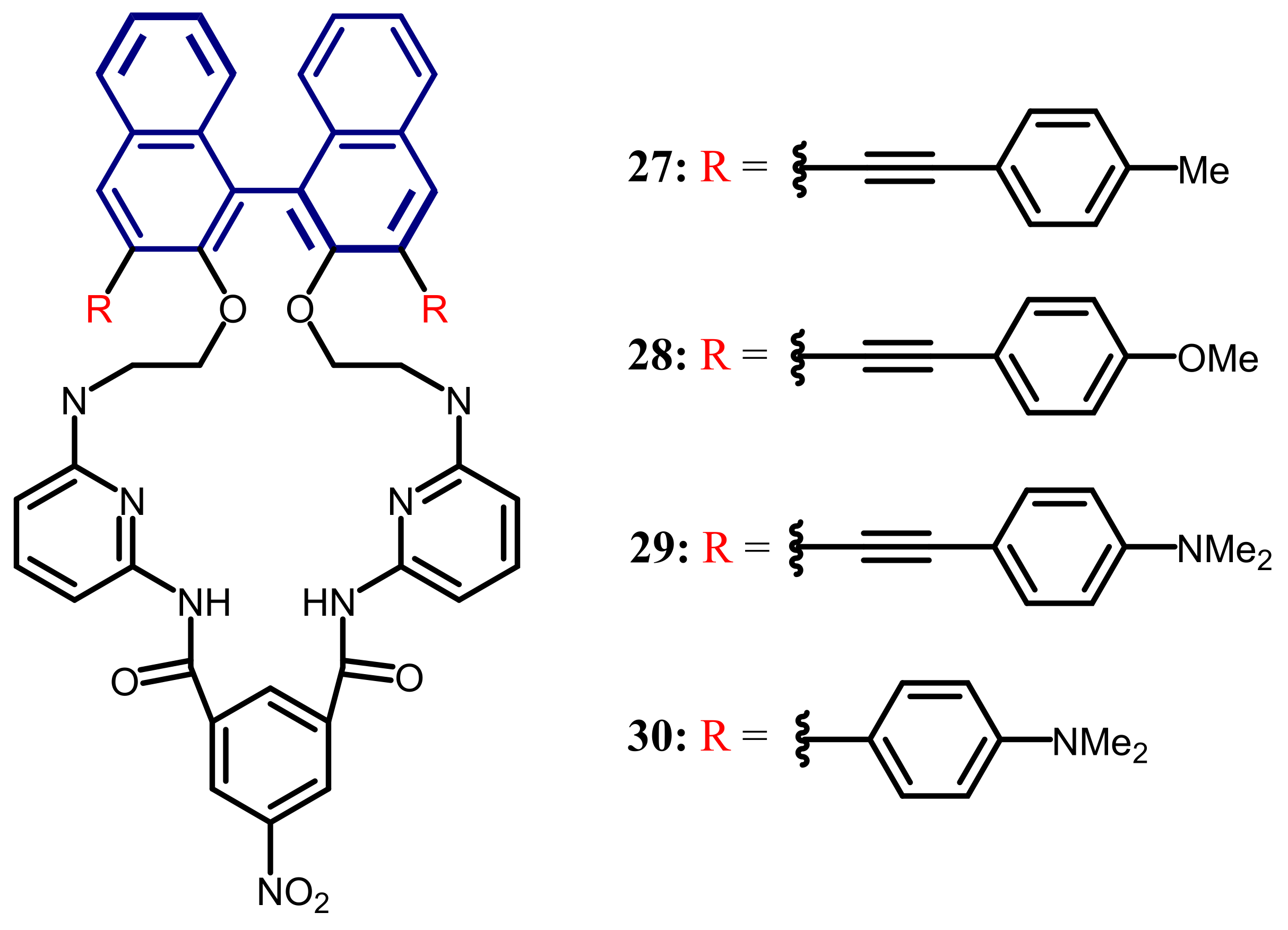
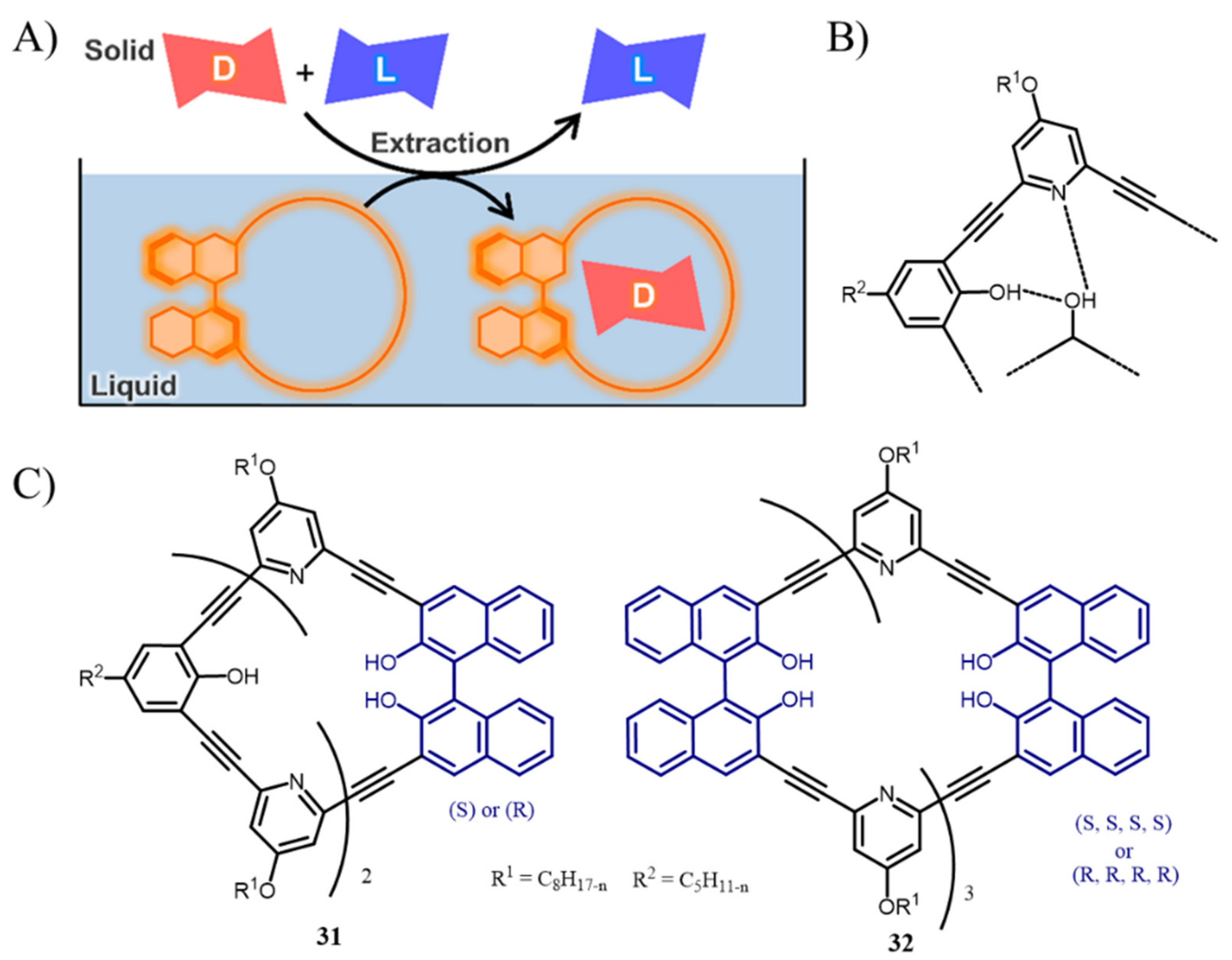
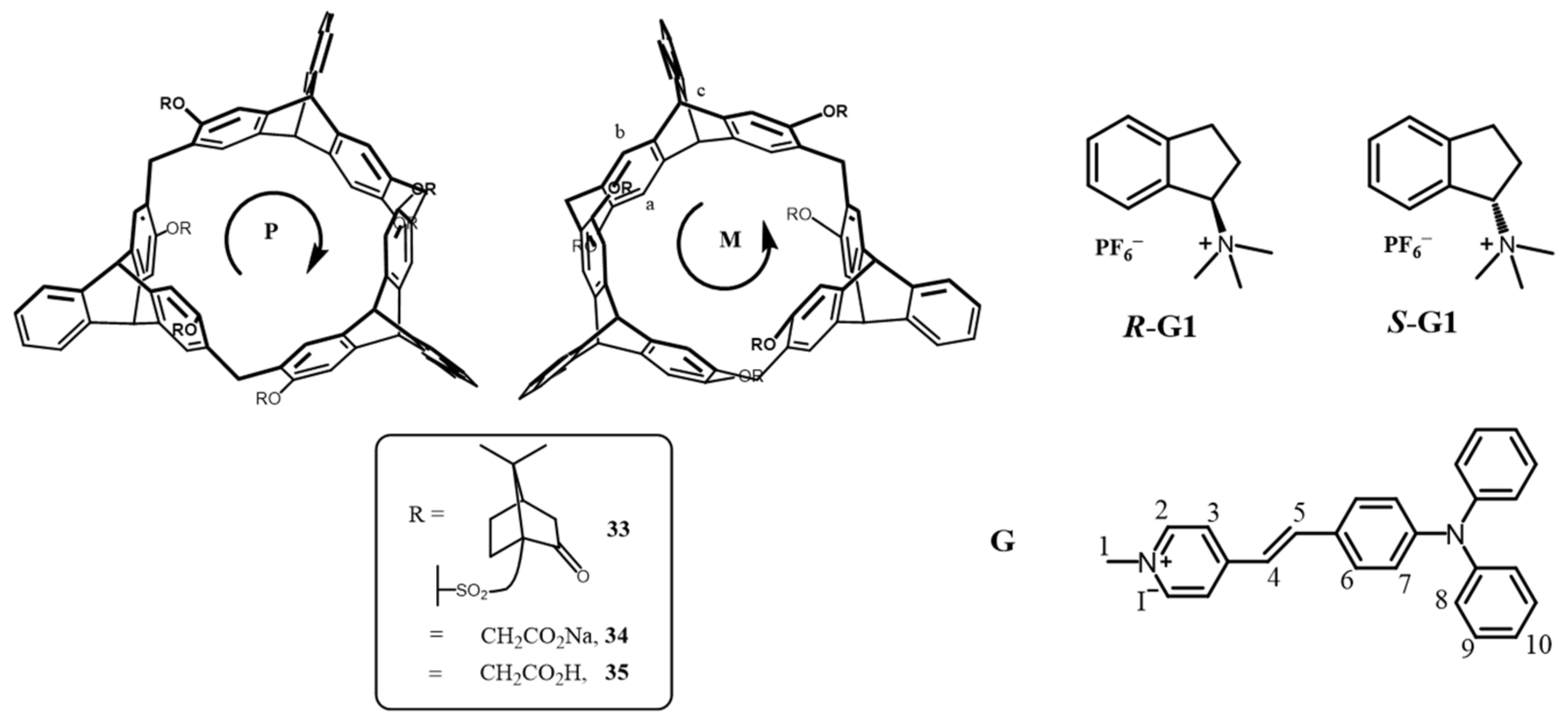
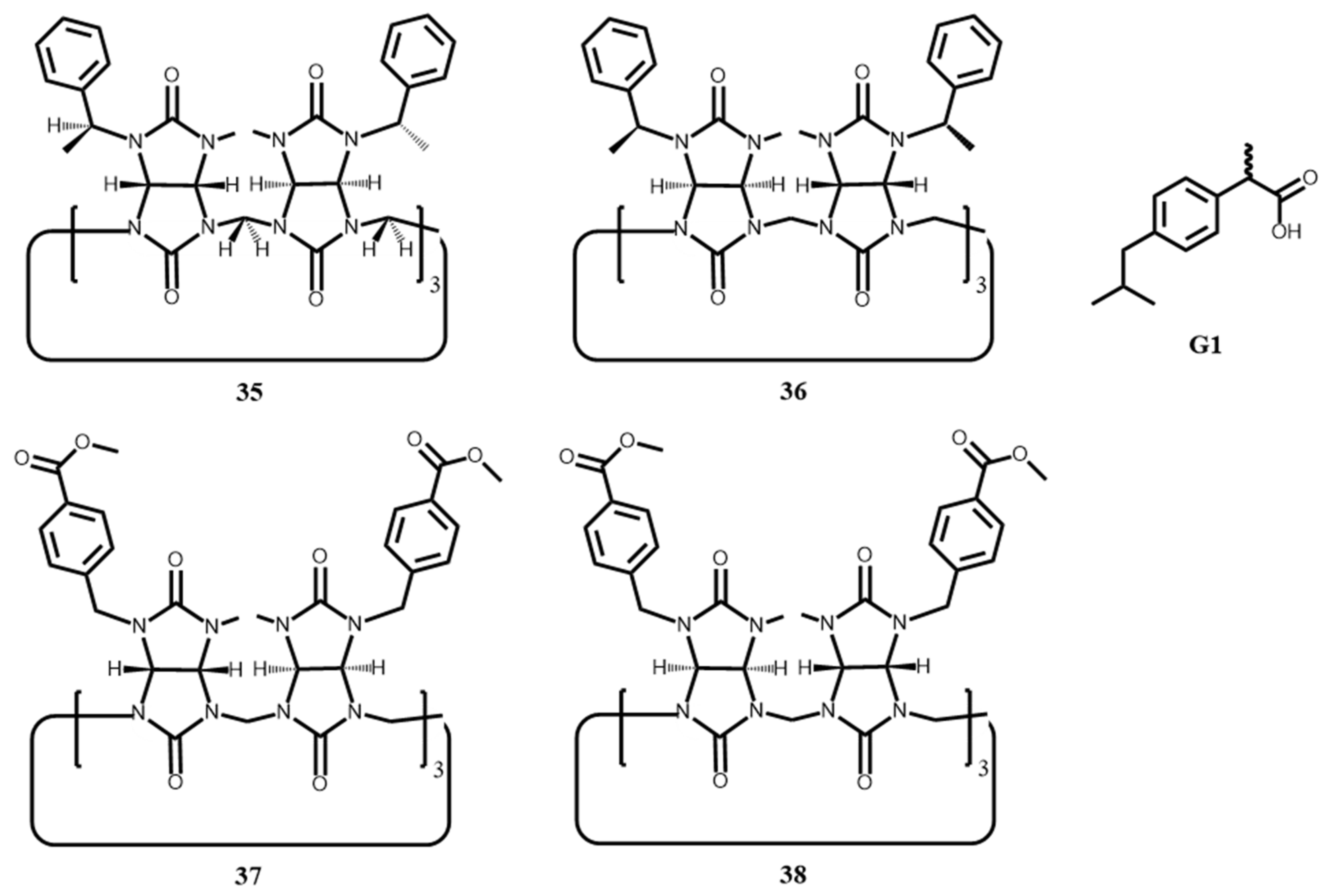
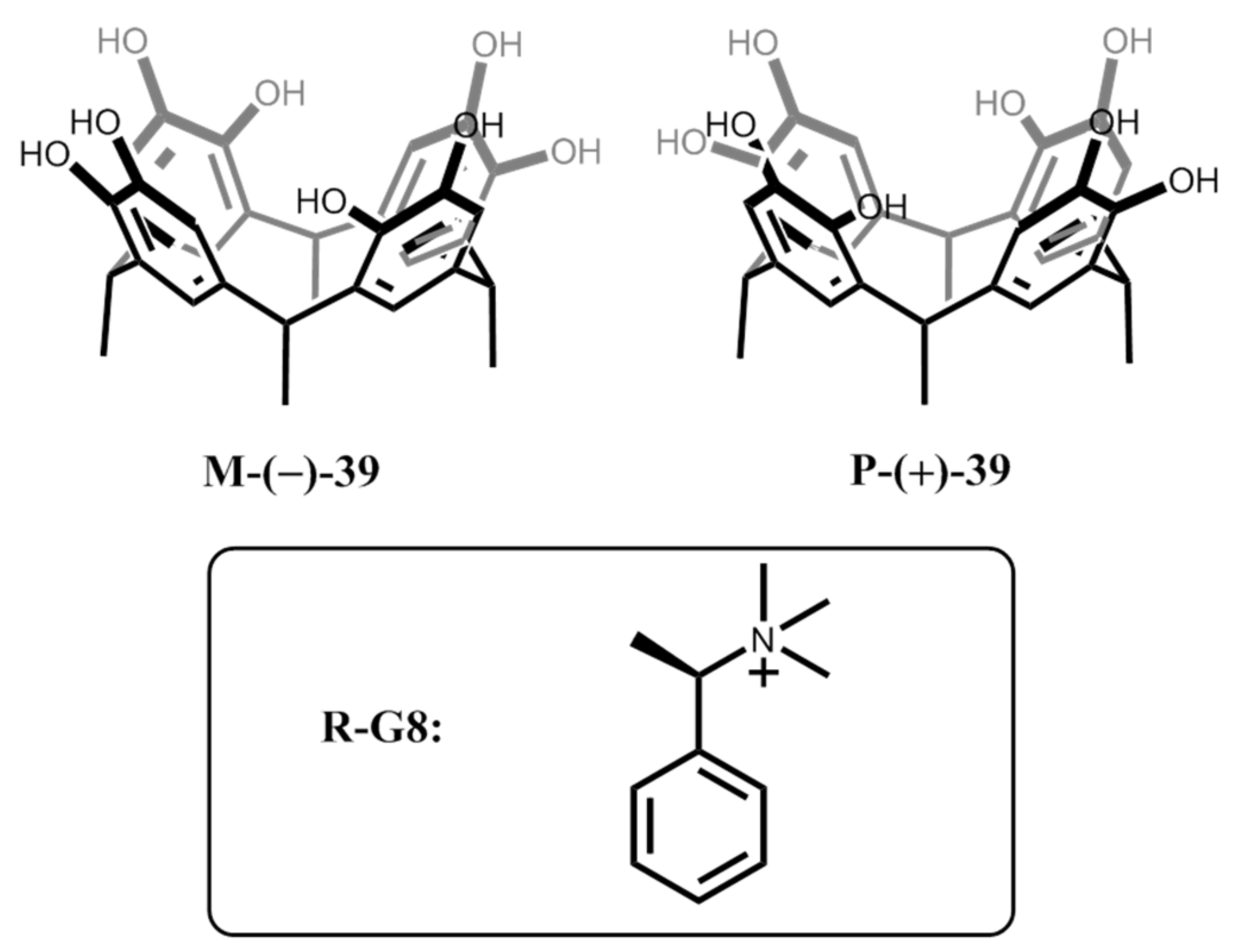
| Achiral Macrocycle | Detection Method | Targeted Substrates | lmax/nm | Δθmax /mdeg | Ka /M−1 |
|---|---|---|---|---|---|
| 1 | CD | hydrocarbons, terpenes, steroids, amino acids, and drugs | 292 and 326 | 24 (D-Trp-OMe) | 102~106 |
| 3 | CD | ammonium salts, amino acids, alcohols, and terpenes, purely aliphatic structures | 270 and 380 | 50 (2-(1-Aminoethyl)Naphthalene) | 106 |
| 4 and 5 | CD | epoxide, alcohol, amine, ester, ether, acetal, sulfinamide, and sulfoximine | 255 | 67 for 4 116 for 5 (epoxides) | 102~106 |
| 6 | CD | carboxylic acid salt | 285, 323, and 350 | 80 (Ac-LeuO−) | 105~107 |
| 7−15 | CD | amino acid ester BArF salt | 283 and 310 | 40 (L-Phe-OMe) | 104~105 |
| 16 and 17 | CD | amino acids, propylene oxide, and 3-butyn-2-ol | 310 and 283 | 5 (Arg) | 104 |
| 18 and 19 | CD | amino acid ethyl ester hydrochlorides | 303 and 247 | 25 for 18 (L-Ala-OEt) | 104 |
| 20 | CD | homooligonucleotide | 405, 477, 617, and 787 | 20 (dT11) | \ |
| 21 | CD | DNA | 200~270, 270~320, and 300~450 | 10 (smDNA) | \ |
| 23 | CD | naphthalene derivatives | 581 | 38 (naphthalene derivatives) | \ |
| Chiral Macrocycle | Targeted Substrate | Ka/M−1 | KR/KS or KL/KD |
|---|---|---|---|
| 27−30 | Carboxylates | 104~106 | 2.25/1 for S-27 (KTP) 1/3.88 for S-28 (IBP) 1/20 for S-29 (PPA) 20/1 for S-30 (PPA) |
| 31 and 32 | Octyl glycosides | 104~105 | 1/2.61 for S-31 1.1/1 for S-32 (oct-β-Fru) |
| 33 | Trimethylamine derivatives | 102~103 | 4.91/1 for P-33 1/6.67 for M-33 (methylated derivative of 1-indamine) |
| 35 | Carboxylic acids | 103 | 1/3.2 (α-methoxy-phenylacetic) |
| 36 | Carboxylic acids | 103 | 1/2.7 (ibuprofen) |
| 37 | Carboxylic acids | 103~104 | 2.0/1 (N-acetyl leucine) |
Publisher’s Note: MDPI stays neutral with regard to jurisdictional claims in published maps and institutional affiliations. |
© 2021 by the authors. Licensee MDPI, Basel, Switzerland. This article is an open access article distributed under the terms and conditions of the Creative Commons Attribution (CC BY) license (https://creativecommons.org/licenses/by/4.0/).
Share and Cite
Liang, X.; Liang, W.; Jin, P.; Wang, H.; Wu, W.; Yang, C. Advances in Chirality Sensing with Macrocyclic Molecules. Chemosensors 2021, 9, 279. https://doi.org/10.3390/chemosensors9100279
Liang X, Liang W, Jin P, Wang H, Wu W, Yang C. Advances in Chirality Sensing with Macrocyclic Molecules. Chemosensors. 2021; 9(10):279. https://doi.org/10.3390/chemosensors9100279
Chicago/Turabian StyleLiang, Xiaotong, Wenting Liang, Pengyue Jin, Hongtao Wang, Wanhua Wu, and Cheng Yang. 2021. "Advances in Chirality Sensing with Macrocyclic Molecules" Chemosensors 9, no. 10: 279. https://doi.org/10.3390/chemosensors9100279
APA StyleLiang, X., Liang, W., Jin, P., Wang, H., Wu, W., & Yang, C. (2021). Advances in Chirality Sensing with Macrocyclic Molecules. Chemosensors, 9(10), 279. https://doi.org/10.3390/chemosensors9100279







